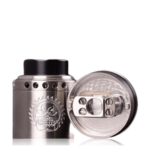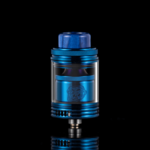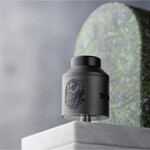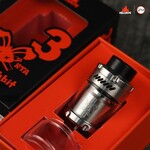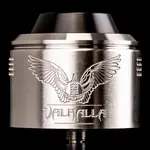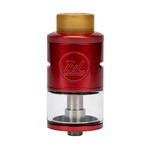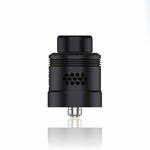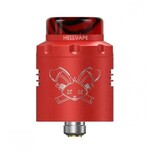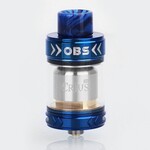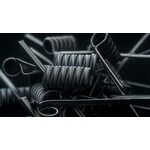What is an RBA vape?
RBA stands for Re-Buildable Atomizer. It’s a sort of DIY type of vape. An RBA is an advanced vape with a deck for user-installed coils and wicks, called “builds.” The term RBA is nowadays used almost exclusively for removable decks for vape tanks, and “rebuildable atomizers” has become a more common term for the wider category. But any atomizer with a build deck (like an RDA, RDTA, RTA, or genesis,) is technically an RBA vape.
This guide will discuss both rebuildable atomizers and RBA heads. The goal is to present the similarities and key differences between the different types of RBAs and help you pick the right atomizer for your needs. If you like the idea of building your own coils and fine-tuning your builds, but you’re lost in the sea of RBA acronyms, keep reading.
What is an RDA?
An RDA stands for Rebuildable Dripping Atomizer. An RDA is a type of RBA that requires the user to manually add juice to the coils and wicks, instead of being fed from a tank. RDAs have a juice well at the bottom of the build deck to hold e-liquid, and the wick tails are placed into the well. Generally, the juice well does not have as much capacity as a tank, so the vaper must continuously add e-juice ever so often, to prevent the wicks from getting dry.
The manual nature of wetting the wicks and coils makes RDAs less convenient than a tank unless they’re set up for and used with a squonk mod. A squonkable RDA can be fed e-juice from a small squeezable bottle that’s located inside the mod, accessed through a small window. Squonking is still manual and it’s a lot like dripping, except that it’s much more convenient than having to carry an e-juice bottle separately.
Different RBA tanks explained
An RTA stands for Rebuildable Tank Atomizer. Of course, all rebuildable tanks are technically RTAs, but the acronym stuck with a particular system as more variations emerged. There are many ways RTAs are designed, but the most universal characteristics of an RTA are:
- An RBA deck for one or two coils (but sometimes more)
- A deck that sits under or in the middle of the tank section
- A chimney and bell system that covers the deck and extends up to the drip tip
The chimney and bell system is a key feature of an RTA that distinguishes it from other RBA tanks. It was first introduced to vaping by the Golden Greek (GG) in 2011 with the iAtty, and now most vape tanks have a similar design. The bell provides a small chamber around the deck, which is sealed off from juice by wicks, creating a vacuum pressure in the tank. This vacuum pressure feeds the wicks with e-juice, evident by the release of bubbles after an inhale. The wick still uses capillary action to absorb the juice, but the vacuum pressure pushes it along quicker which can make the wicking more efficient—especially in higher power applications. The vapor travels up through the chimney making a concentrated stream, which some argue is better for flavor.
RBA heads
RBA heads are enclosed decks that work with sub ohm tanks as well as pod systems. The RBA deck can take the place of a factory-made coil head, and the user can control their own builds. The characteristics of an RBA head:
- Removable and replaceable like a normal coil head
- For use with specific vapes (most tanks do not have an RBA head)
- For use with up to two coils (rarely more)
Those vape tanks that come with an RBA head provide the user with an entry-level device and one that can be grown into as experience increases. RBA heads almost disappeared a couple of years ago, but they have lately made a resurgence as more and more pod vape RBAs started appearing on the market.
RDTA
An RDTA stands for Rebuildable Dripping Tank Atomizer. As the acronym implies, an RDTA blends together characteristics from RDAs and RTAs. The deck of an RDTA is designed like that of an RDA and the performance is similar, but the tank section that’s under the deck can feed juice to the build without having to constantly drip. The main characteristics of an RDTA are:
- A deck commonly for one or two coils (but sometimes more)
- A deck that typically sits above the tank section
- No bell and chimney system like typical RTAs
The original RDTA was the Big Dripper from Subohm Innovations, and it was simply an RDA that had a spring-loaded tank section sitting on top of the deck. It fed the coils and wicks from a manual pumping action. While it was the first official RDTA, its design didn’t carry over with the others that came out after. Now an RDTA is simply an RDA with a tank section that acts as a deep well.
RTA vs RDTA vs RDA vs RBA
When trying to understand the differences in these types of devices, the thing to remember is that they’re all rebuildable and require the user to know how to build and wrap vape coils, as well as having a firm grasp on ohms law and battery safety.
RBA vs RDA: An RDA is a type of RBA that doesn’t come with a tank section.
RDA vs RTA: The RDA requires manually wetting the wicks and coils with e-juice instead of coming from the tank section, like in an RTA. Most RTAs hold at least a couple milliliters of e-juice, and most RDAs may only hold a small portion of that.
RDTA vs RDA: An RDTA is like an RDA that has a tank. Instead of having to drip manually on the coils and wicks like in an RDA, the RDTA has a tank section for storing extra juice.
RTA vs RDTA: An RTA and RDTA are both rebuildable tanks, but RTAs typically have a deck on the bottom of the atomizer and use a chimney and bell system. On the other hand, under the top cap, RDTAs typically have an open deck above the tank where the wicks hang.


